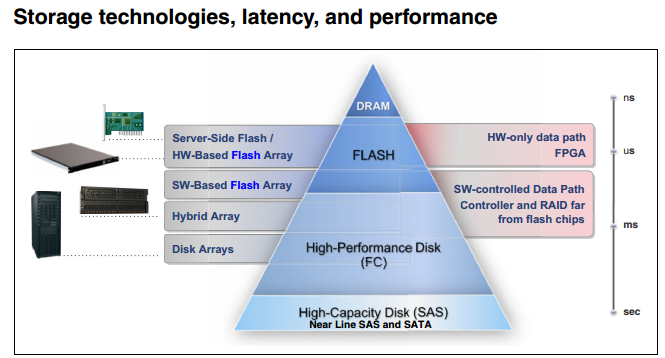The Exponential Data Growth Challenge
Today’s businesses are struggling with the exponential growth of data and an increasing pressure on the data center to become more efficient. To address this issue, a traditional "one size fits all" strategy for storage design is no longer adequate.
Some of the trends that contribute to the challenge, such as server virtualization, proliferation of multi-core processors, and a rising adoption of desktop virtualization, are increasing the requirement for high I/O performance with low latency and very fast response times. On the other side of the spectrum, an explosive growth of unstructured data also drives the need for capacity-optimized storage.
All-Flash Arrays vs. Hybrid Flash Storage Systems
Flash-optimized storage will accelerate your applications while delivering Tier 0 data services to ensure resiliency and quality of service. However, to design a flash-optimized storage environment, it’s important for you to first understand how pure all-flash arrays are fundamentally different from hybrid systems that incorporate solid-state drives (SSD) technology.
All-Flash arrays have a hardware-only data path that takes full advantage of Flash technology to provide performance. However, hybrid arrays try to incorporate SSD technology into technology that was designed for HDDs; hence there is inherent latency built into the architecture. Also, SSDs in hybrid systems have the added overhead of the drive carrier and raid controllers that also add latency to the data path.
The following illustration shows the typical points that add to latency for various types of storage technologies. (Source:
Flash or SSD: Why and When to Use IBM FlashSystem –
a Red paper from IBM)

Note:
In the diagram above, be aware that SSD drive implementations would provide millisecond response times, whereas hardware-based flash array will provide microsecond response times because of the inherent latency built into hybrid architectures. Both technologies have their place depending on what the performance requirements you need.
The Benefits of Flash
- Reduction in application processing time, physical footprint, and power consumption.
- Microsecond latency response time to accelerate critical applications to achieve competitive advantages
- Non-invasive integration into existing environment
Where should you be using Flash?
- For application acceleration: databases, VDI, virtualized servers, etc
- For latency sensitive applications: metadata for file systems, video transcoding, rendering, analytics, etc
- To consolidate Data Centers: flash allows for fewer processers, which lead to fewer servers/licenses, and hence smaller data centers
Is Flash too expensive?
Short stroking hard disk drives (HDDs) is a common occurrence. If you compare the cost of HDD purchases based on performance requirements, and the cost of purchasing just enough Flash based on capacity requirements, HDDs are actually more expensive.
Flash EQUALS Pure Performance
Flash has become more prevalent in storage technology projects. The question is no longer IF you should use a flash-based system, but rather, where to put the flash. All-flash storage systems, either implemented as performance-augmenting appliances or as replacement arrays for traditional HDD systems, are another alternative -- and one that's making better economic sense every day as the effective cost-per-gigabyte differential between high-performance disk drives and SSDs keeps shrinking.
Businesses are re-thinking their data center architectures in favor of server-side SSDs due to the performance and cost advantages of enterprise-grade solid-state storage solutions. Hybrid arrays do not provide the same performance as pure flash arrays, but there is a place for each, depending on the workload.
Storage Efficiency Technologies
All-flash storage arrays can also include storage efficiency technologies such as deduplication, thin provisioning and compression because these processes work well in solid state storage. These data reduction technologies can reduce the effective cost per gigabyte, which has historically been the primary impediment to wider adoption of flash storage devices.
Solid-state storage in storage arrays has evolved from a premium high-end feature to a performance-boosting option in a large number of midrange and high-end storage systems.
Read more:
Flash or SSD: Why and When to Use IBM FlashSystem – a Red paper from IBM
Considering Flash to help your business transform its infrastructure to become more physically and operationally efficient?
Engage Sentia to help design the proper solution balancing cost/performance for your business. Call Sentia for strategic advice at 1-866-610-8489 or feel free to drop me a line here.
Paul Oh, VP, Technical Services
Sentia